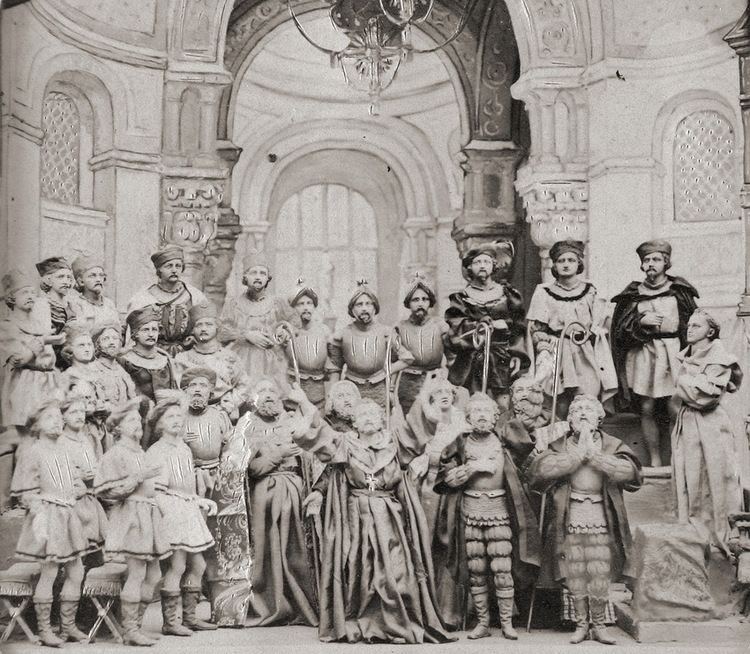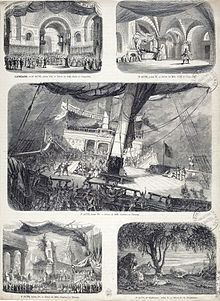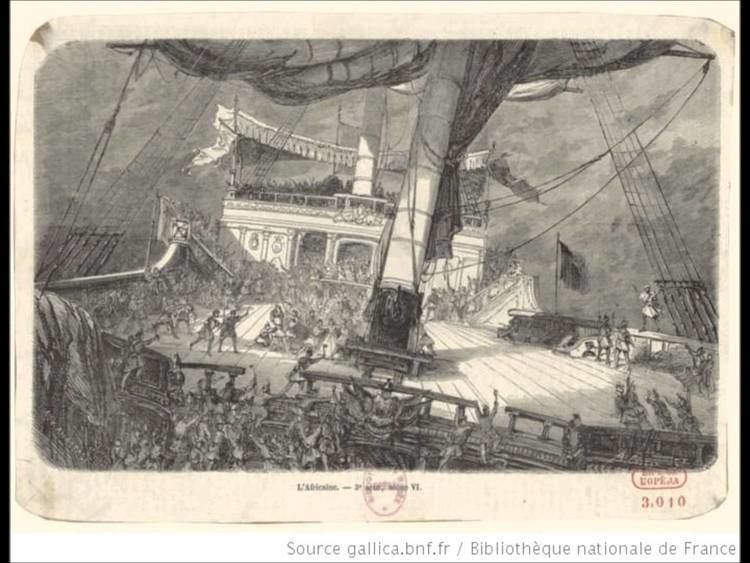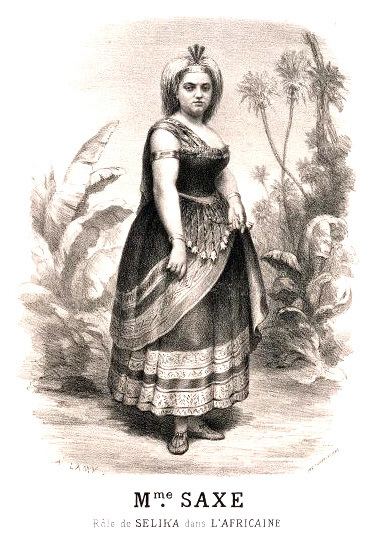First performance 28 April 1865 | Written 1864 Language French | |
 | ||
Similar Les Huguenots, Le prophète, Robert le diable, Le pardon de Ploërmel, La Juive | ||
Giacomo meyerbeer vasco da gama l africaine act i finale
L'Africaine (The African Woman) is a grand opera in five acts, the last work of the composer Giacomo Meyerbeer. The French libretto by Eugène Scribe deals with fictitious events in the life of the Portuguese explorer Vasco da Gama – Meyerbeer's working title for the opera was in fact Vasco da Gama. The opera had its first performance by the Paris Opéra at the Salle Le Peletier on 28 April 1865.
Contents
- Giacomo meyerbeer vasco da gama l africaine act i finale
- Giacomo meyerbeer l africaine prelude
- Performance history
- Synopsis
- Act 1
- Act 2
- Act 3
- Act 4
- Act 5
- Set designs for the premiere
- References

Giacomo meyerbeer l africaine prelude
Performance history

The opera was premiered in a performing edition undertaken by François-Joseph Fétis, as the composer had not prepared a final version by the time of his death the previous year. It is Fétis who gave the work its present title; Meyerbeer had referred to it as Vasco de Gama. In fact it is clear from the text, with its references to Hinduism, that the heroine Sélika hails not from Africa, but from a region of, or island nearby, India. Madagascar has been suggested as a compromise reconciliation. Gabriela Cruz has published a detailed analysis of the historical context of the events of the opera and the opera setting itself.

Meyerbeer worked on the score from 1854 to 1855. He had intended the role of Sélika for the soprano Sophie Cruvelli, but Cruvelli's abrupt retirement from the public stage in January 1856 interrupted his plans.

The work had its British premiere at Covent Garden Theatre, London, on 22 July 1865, and in New York on 1 December 1865. It also received its Italian premiere in 1865 in Bologna, conducted by Angelo Mariani and was staged four times at La Fenice between 1868 and 1892. It was also performed in Melbourne, Australia, in July 1866.

The opera was enormously successful in the 19th century, but today it is rarely revived. Plácido Domingo has sung it in at least two productions: a revival at the War Memorial Opera House in San Francisco that premiered on November 13, 1973; and in 1977 at the Liceu in Barcelona, with Montserrat Caballé. To mark the 150th anniversary of Meyerbeer's death, the work was performed again at La Fenice in November 2013. Most modern performances and recordings are severely cut to give prominence to the parts of da Gama and Sélika, and therefore they cannot give a full idea of the composer's conception, which in any case has been to some extent obscured by the version prepared by Fétis.
In 2013, Meyerbeer's original version in a new critical edition by Jürgen Schläder was performed by Chemnitz Opera under the original title Vasco de Gama. The production was a success with audiences and critics and won the poll of German critics award presented by Opernwelt magazine annually as "Rediscovery of the year" in 2013. This edition was also used for a production at the Deutsche Oper in October 2015, with Roberto Alagna as Vasco da Gama and Sophie Koch as Sélika.
The best known part of the opera is the act 4 tenor aria "Pays merveilleux ... O, paradis", which has been recorded many times.
Synopsis
The opera depicts fictional events in the life of the explorer Vasco da Gama.
Place: Lisbon, at sea, and in an exotic new landTime: late 15th centuryAct 1
The council chamber, Lisbon
The beautiful Inès is forced by her father, the Grand Admiral Don Diego, to marry Don Pédro instead of her true love, Vasco da Gama. Da Gama, who is thought to have died in the expedition of Bartolomeu Dias, appears at the Grand Council saying he has discovered a new land, and displaying Sélika and Nélusko as examples of a newly discovered race. His request for an expedition is refused, causing da Gama to attack the Grand Inquisitor, who anathematises him. Da Gama is then imprisoned.
Act 2
The prison
Sélika, who is in fact queen of the undiscovered land, saves da Gama, whom she loves, from being murdered by Nélusko, a member of her entourage. Inès agrees to marry Don Pédro if da Gama is freed; da Gama, not realising that Inès has made this bargain, and noticing her envy of Sélika, gives her Sélika and Nélusko as slaves. Don Pédro announces he is to mount an expedition to the new lands that were da Gama's discovery. Nélusko offers his services as pilot.
Act 3
On Don Pedro's ship
Nélusko is navigating the ship, but is secretly planning to destroy the Europeans. He sings a ballad of the legend of Adamastor, the destructive giant of the sea. Nélusko gives orders which will direct the ship into an oncoming storm. Da Gama has followed Don Pédro in another ship, and begs him to change course to avoid destruction. Don Pédro refuses, and orders him to be chained. The storm breaks out. Nélusko leads the local people to kill all the Europeans on the ships and only da Gama is spared.
Act 4
Sélika's island
Sélika is met with a grand celebration and swears to uphold the island's laws, which include the execution of all strangers. Da Gama is captured by priests, who intend to sacrifice him. He is amazed by the wonders of the island, and sings the most famous aria of the opera O Paradis! (O Paradise!). Sélika saves him by saying that he is her husband, forcing Nélusko to swear this is true. Da Gama resigns himself to this new life, but hearing the voice of Inès, who is being taken to her execution, he rushes to find her.
Act 5
The island
The reunion of da Gama and Inès is interrupted by Sélika, who feels betrayed. When she realises the strength of the lovers' affection, she allows them to return to Europe, telling Nélusko to escort them to da Gama's boat. She then commits suicide by inhaling the perfume of the poisonous blossoms of the manchineel tree. Nélusko follows her into death.
Set designs for the premiere
The stage designs for the original production at the Paris Opera were created by Auguste-Alfred Rubé and Philippe Chaperon for Act 1 (Council Scene) and Act 2 (Dungeon Scene); Charles-Antoine Cambon and Joseph Thierry for Act 3 (Sea Scene and Shipwreck) and Act 4 (Hindu Temple); Jean-Baptiste Lavastre for scene 1 of Act 5 (Queen's Garden, not shown); and Edouard Desplechin for scene 2 of Act 5 (The Manchineel Tree). Engravings depicting the amazing sets appeared in periodicals throughout Europe. The final scene designed by Desplechin received special praise for its originality. Possibly because of advance publicity and high expectations, the Shipwreck Scene of act 3, executed by numerous stagehands, was deemed by the press to be somewhat disappointing. However, Arthur Pougin writing in 1885 identified the scene as the epitome of the company's grand opera mise en scène.
